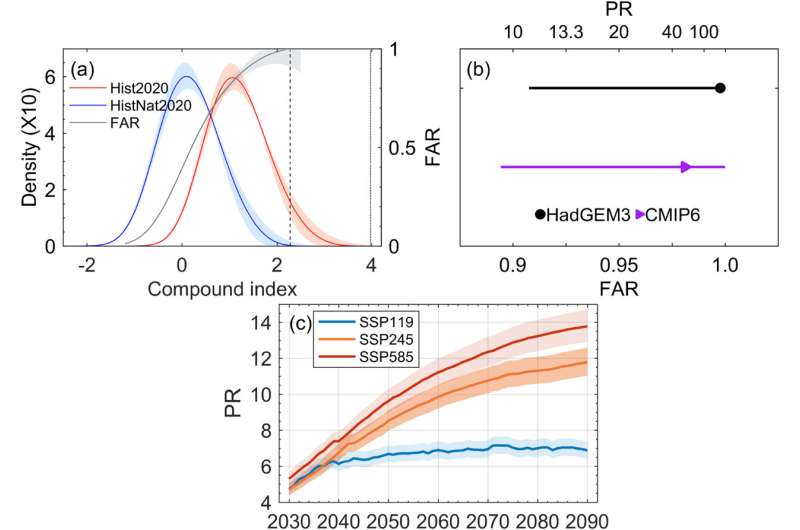Anthropogenic climate change heightens risks of spatially compounding flooding and heat wave events: Study
Compound extreme events, defined as those where multiple climate extremes converge, often result in more severe and devastating impacts than individual events. Specifically, spatially compounding events, where different climate hazards co-occur across neighboring regions, have been a focus of concern.
Researchers from the Institute of Atmospheric Physics of the Chinese Academy of Sciences and their collaborators have delved into the realm of compound extreme events, revealing their heightened risk due to human-induced climate change.
The study was published in Weather and Climate Extremes.
The researchers developed a framework for attributing spatially compounding events involving two different hazards. They used a storyline-probability combined model, which enhanced the confidence in attribution statements. Additionally, they introduced a novel constructed flow analogs method to assess the dynamic effects contributing to such events.
Presenting a case study on the 2020 spatially compounding heavy precipitation and heat wave event in China, the research team found that dynamic and thermodynamic factors accounted for 51% (35%–67%) and 39% (18%–59%) of the event’s intensity, respectively. Moreover, their analysis revealed that anthropogenic climate change has increased the likelihood of similar events by at least tenfold.
Projections indicate that compared to the current climate, these events may become 10 and 14 times more probable by the mid and late 21st century, respectively, under a high-emissions scenario. Notably, adopting a low-emissions scenario could reduce this likelihood to 7 times more probable.
This study not only sheds light on the profound influence of anthropogenic climate change on high-impact compound extreme events but also underscores the urgent need for greenhouse gas emissions reduction.
More information:
Cheng Qian et al, Human influences on spatially compounding flooding and heatwave events in China and future increasing risks, Weather and Climate Extremes (2023). DOI: 10.1016/j.wace.2023.100616
Citation:
Anthropogenic climate change heightens risks of spatially compounding flooding and heat wave events: Study (2023, November 13)
retrieved 13 November 2023
from https://phys.org/news/2023-11-anthropogenic-climate-heightens-spatially-compounding.html
This document is subject to copyright. Apart from any fair dealing for the purpose of private study or research, no
part may be reproduced without the written permission. The content is provided for information purposes only.

Compound extreme events, defined as those where multiple climate extremes converge, often result in more severe and devastating impacts than individual events. Specifically, spatially compounding events, where different climate hazards co-occur across neighboring regions, have been a focus of concern.
Researchers from the Institute of Atmospheric Physics of the Chinese Academy of Sciences and their collaborators have delved into the realm of compound extreme events, revealing their heightened risk due to human-induced climate change.
The study was published in Weather and Climate Extremes.
The researchers developed a framework for attributing spatially compounding events involving two different hazards. They used a storyline-probability combined model, which enhanced the confidence in attribution statements. Additionally, they introduced a novel constructed flow analogs method to assess the dynamic effects contributing to such events.
Presenting a case study on the 2020 spatially compounding heavy precipitation and heat wave event in China, the research team found that dynamic and thermodynamic factors accounted for 51% (35%–67%) and 39% (18%–59%) of the event’s intensity, respectively. Moreover, their analysis revealed that anthropogenic climate change has increased the likelihood of similar events by at least tenfold.
Projections indicate that compared to the current climate, these events may become 10 and 14 times more probable by the mid and late 21st century, respectively, under a high-emissions scenario. Notably, adopting a low-emissions scenario could reduce this likelihood to 7 times more probable.
This study not only sheds light on the profound influence of anthropogenic climate change on high-impact compound extreme events but also underscores the urgent need for greenhouse gas emissions reduction.
More information:
Cheng Qian et al, Human influences on spatially compounding flooding and heatwave events in China and future increasing risks, Weather and Climate Extremes (2023). DOI: 10.1016/j.wace.2023.100616
Citation:
Anthropogenic climate change heightens risks of spatially compounding flooding and heat wave events: Study (2023, November 13)
retrieved 13 November 2023
from https://phys.org/news/2023-11-anthropogenic-climate-heightens-spatially-compounding.html
This document is subject to copyright. Apart from any fair dealing for the purpose of private study or research, no
part may be reproduced without the written permission. The content is provided for information purposes only.
